Abstract
Here, a new method is recommended to characterize a new continuous distribution class, named the generalized alpha exponent power family of distributions (GAEPFDs). A particular sub-model is presented for exemplifying the objective. The basic statistical properties, such as ordinary moments, the probability weighted moments, mode, quantile, order statistics, entropy measures, and moment generating functions, etc., were explored. To gauge the GAEPPRD parameters, the ML technique was utilized. The estimator behaviour was studied by a Monte Carlo simulation study (MCSS). The effectiveness of GAEPFDs was demonstrated observationally through lifetime data. The applications show that GAEPFDs can offer preferable results over other competitive models.
Keywords:
Monte Carlo simulation; moments; G-family; maximum likelihood estimation; power Rayleigh distribution MSC:
60E05; 62E15
1. Introduction
The Rayleigh distribution (RD) [] serves as a model in agriculture and health, analyzing wind speed data, hydrological characteristics, communications theory, engineering, etc. It originates from two parameters. The Weibull distribution (WD), whereas shape parameter is equal to 2; and a random variable (r.v.), Z, follows an RD with scale parameter if it has a cumulative distribution function (CDF), such as
An r.v. follows a power Rayleigh distribution (PRD) with and as the scale and shape parameters if it has CDF given as
In the most last twenty years, many researchers have contributed toward developing new distributions through variable alterations. Moreover, they have used techniques, such as (i) composition, (ii) compounding, and (iii) finite mixtures of distributions. A few generalized families include: Beta-G [], Weibull-G [], Kumaraswamy-G [], McDonald-G [], exponentiated-G [], odd-gamma-G [], Marshall-G [], moment exponential-G [], Lomax-G []. For more details on well-known G-classes, refer to [].
The new idea in generalization began when the transformed-transformer (T-X) family of the distribution was proposed by []. Let T be a r.v., having a p.d.f , where , , and let X be a r.v., , a function of , fulfill (i)–(iii) conditions as under:
- (i)
- ;
- (ii)
- is monotonically increasing and differentiable; and
- (iii)
- ⟹ and ⟹.
The family of distributions T-X having CDF, , is
The p.d.f corresponds to (3) is
Recently, a technique, known as the alpha power transformation (APT), presented in [], added an extra shape parameter to an existing lifetime distribution to bring more flexibility to the given distribution. The APT has CDF, as
and the corresponding p.d.f has the form
Here, and are the CDF and p.d.f of any continuous baseline distribution with r.v. X. The APT has been used by many researchers to develop new distributions and data analysis purposes. In [], it is observed that a generated two parameter (shape and scale) alpha power exponential distribution (APED) behaves similar to the two-parameter generalized exponential (GE), gamma, or Weibull distributions, and take similar shapes of p.d.f and HRF. Reference [] defined a method of introducing two extra parameters to a baseline distribution called the modified APT (MAPT). The CDF of the MAPT is defined as
The corresponding p.d.f has the form
For three extra parameters in the model, we can use . In [], the modified APED (MAPED) with three parameters ( as shape and as rate) is proposed. The extra parameters in the exponential distribution produced asymmetrical densities to the right and left and change the tail length. The p.d.f of the MAPED is a concave function and has increasing HRF. The MAPED succeeded to fit the real data as compared to APED [], among others.
The main motivations for developing the new G-family are:
- (i)
- Constructing new G-families as a function of a CDF, .
- (ii)
- The proposed extension of the APT is based on a generator instead of the existing generator .
- (iii)
- The proposed generator has the power to produce better results of estimates and goodness of fit tests that can make it attractive and distinguishable for applied researchers.
Combining the ideas of (3) and (4), we introduce a new flexible distribution class, called the generalized alpha exponent power-G (GAEP-G) family. Let
be the CDF of a r.v. T. The p.d.f corresponding to (5) is
The p.d.f related to (7) is
GAEPFDs can serve as leading models to widely applied classes in disasters, agriculture, engineering, health, and hydrological characteristics, such as precipitation, flood, storm events, and wind speed data.
The paper is laid out as follows: in Section 1, GAEPFDs as a new family is presented. In Section 2, a sub-model, GAEPPRD, is characterized and gives plots of p.d.f, CDF, reliability, and HRF. In Section 3, we derive some statistical properties. Estimation of GAEPPRD parameters and ACBs are tended to in Section 4. In Section 5, the MCSS is provided. In Section 6, we describe the importance of GAEPFDs through two applications to lifetime data. Finally, the conclusion is presented in Section 7.
2. The Generalized Alpha Exponent Power Power Rayleigh Distribution (GAEPPRD)
The p.d.f of GAEPPRD analogous to (9) is
Using (9), the reliability of GAEPPRD is
Graphs of p.d.f, CDF, reliability, and HRF of GAEPPRD for some selected values of parameters are shown in Figure 1 and Figure 2. In Figure 1, the shapes of the GAEPPRD p.d.f are reversed-J, right- skewed and unimodal; as expected, the CDF shows the increasing pattern. Figure 2 displays that the reliability graph tends to decrease as the time increases and the HRF curve shows shapes, such as the first increase and then the decrease and reversed-J.
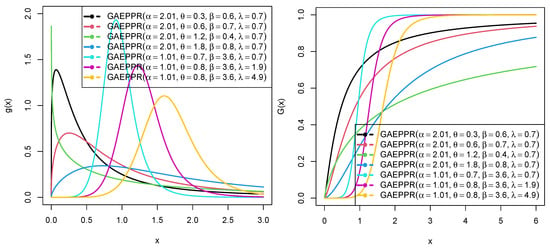
Figure 1.
The p.d.f and CDF plots of the GAEPPRD.

Figure 2.
Plots for reliability and HRFs of the GAEPPRD.
Let a continuous r.v. X with reliability function specified in (11); the mean residual life function (MRLF) of GAEPPRD is the average value of the remaining lifetimes after a time point x. The MRLF is expressed as
Using the incomplete beta type II distribution, we obtain the first incomplete moment , where
, and .
3. Statistical Properties
Here, we concentrate on a few statistical properties of the GAEPPRD.
3.1. Moments
Using the series, , we have
Let , then from (17), we have
After simplifying, we have
Using the definition of type-II Beta distribution, , we have
3.2. Moment Generating Function (MGF)
The MGF is given as
Using p.d.f (10), and the series and , , the MGF of GAEPPRD, is given as
3.3. Mode
When GAEPPRD approaches to its maximum point, it is called mode.
Taking the natural logarithm of p.d.f (10), and the differentiating w. r. t. x and equating it to zero yields
3.4. Quantile Function (QF)
3.5. Skewness and Kurtosis Using Quantile Approach
Given the QF, as in (24), Moor’s kurtosis [] based on octiles is given as
Moreover, the quartile-based Bowley measure of skewness [] is given as
3.6. The Mean Deviation (MD)
3.7. Rényi Entropy (RE)
A measure of variation of uncertainty is known as entropy. Renyi [] defined entropy as
3.8. The Probability Weighted Moments (PWMs)
For r.v. X, the PWMs can be derived by the following expression
We consider the generalized binomial series, which hold for any real number b and
3.9. Distribution of Order Statistic (OS)
In a real-life study and reliability analysis, the OS has been widely used. Let are the OS of a random sample drawn from GAEPPRD with (9) and (10), then p.d.f of is given by
Using (32), we obtain as
Here, is defined as
Further, for GAEPPRD, the moment of kth OS is defined as
4. Maximum Likelihood (ML) Estimation
Here, from a complete sample only, we obtain the ML estimators (MLEs) of for GAEPPRD. Let the observed values, , be obtained from (10) with parameters . The expression of the log-likelihood function (LLF) for can be given as
Setting
and solving, simultaneously, yields , the MLEs, of . The analytical solutions of Equations (46)–(49) cannot be obtained. Consequently, to numerically solve these equations, computer software Maple, Mathematica, MATLAB, and R can be utilized.
Asymptotic Confidence Bounds (ACBs) of GAEPPRD
Here, elements of the observed information matrix (OIM), with the order , are required to estimate the confidence interval’s (CIs) of . OIM, (for ), where can be approximated by
Using standard regularity conditions, the asymptotic distributions (ADs) of the GAEPPRD parameters are
where is the variance covariance matrix (VCM) of . Here, evaluated at is the total OIM. Then, the approximate CIs for , and , based on the ADs of the GAEPPRD, are determined, respectively, as
and
where, the main diagonal of has ’s corresponding to , and is the upper percentile of the standard normal distribution (SND). The derivatives in the OIM () for the unknown parameters are given as
5. Monte Carlo Simulation Study (MCSS)
Here, we check the behaviour of the MLEs in terms of n (sample size). MCSS is conducted to analyze the MLE behaviour for GAEPPRD. It is utilized for maximizing the function (41). The number of MC replicates are made 1000 times each with random samples of sizes. We obtain the average MLEs, mean square errors (MSEs), biases, and absolute biases (ABs) at each sample size using the R package. The mathematical formulae of the average MSE and bias are as under
where . Empirical results acquired after performing MCSS are reported in Table 1 and graphically arranged in Figure 3, Figure 4, Figure 5, Figure 6 and Figure 7. We can observe from these tables and figures that:

Table 1.
Results of the simulation (MLE, MSE, and bias) for GAEPPRD are reported.
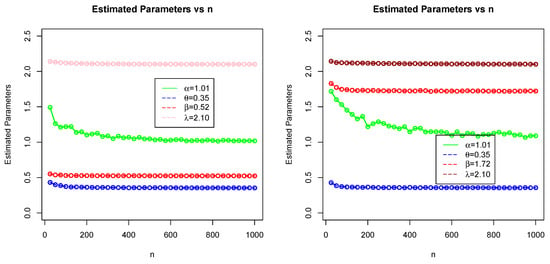
Figure 3.
Plots of MLEs of the GAEPPRD for Set 1: and Set 2: .

Figure 4.
For set 1, MSE plots of GAEPPRD: .
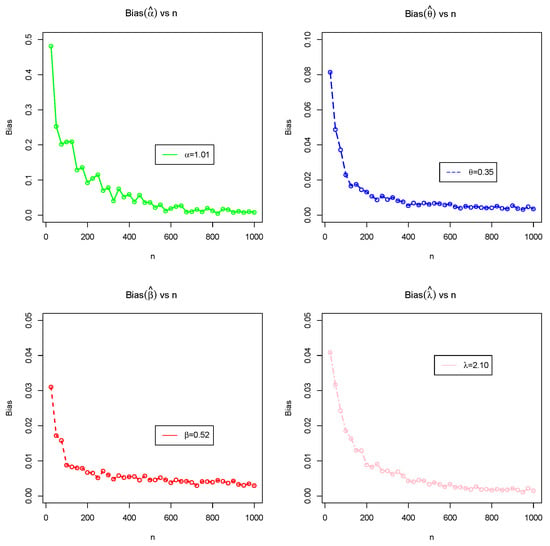
Figure 5.
For set 1, bias plots of GAEPPRD: .
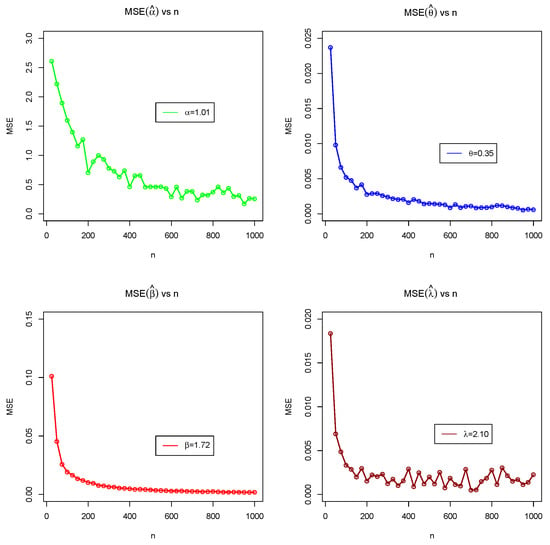
Figure 6.
For set 2, , MSE plots of the GAEPPRD.

Figure 7.
For set 2, , bias plots of the GAEPPRD.
- MSE and biases decrease as n increases.
- Estimates of GAEPPRD are very steady and are nearer to the true value of parameters as n increases.
6. Applications
Here, we present applications of derived models using lifetime datasets. We compare fits of the GAEPPRD with other known lifetime models.
To verify which model is suitable for the considered data, we used certain analytical measures (AMs). These AMs included (i) discrimination measures (DMs) and (ii) goodness of fit measures (GFMs). The DMs are given by
- Akaike information criterion (IC)
- Bayesian IC
- The Hannan–Quinn IC
- Consistent AIC
The GFMs are given by
- Test statistics: Anderson–Darling (AD)
- Test statistics: Cramér–von Mises (CM)where is LLF at MLEs, q (no. of model parameters), n (sample size), and (calculated value at the position in the sample point according to ascending order).
6.1. Dataset 1
From [], the strength of glass fibers, length 1.5 cm, dataset was taken, consisting of 72 observations. The observations are as follows:
12, 95, 15, 96, 22, 98, 99, 109, 24, 24, 110, 32, 32, 33, 34, 38, 38, 43, 44, 121, 48, 127, 52, 129, 53, 54, 54, 131, 55, 56, 143, 146, 146, 57, 58, 58, 59, 60, 60, 175, 175, 60, 60, 61, 62, 63, 65, 65, 67, 68, 70, 70, 72, 91, 73, 87, 75, 85, 76, 84, 76, 83, 81, 211, 233, 258, 258, 263, 297, 341, 376, 341.
6.2. Dataset 2
As reported by [], the water runoff (in mm) of 34 storm events; dataset observed from a mall watershed in Korea (west of the city of Suwon). The observations are as follows:
0.9, 0.6, 16.8, 59.3, 2, 78.2, 30.7, 146.8, 1.8, 3.4, 1.1, 0.8, 2.5, 6.1, 17, 5.1, 216.2, 8.1, 1.6, 2, 2, 0.8, 0.8, 2.9, 7.3, 13.3, 181.7, 20.5, 24.1, 33.5, 89.1, 7.2, 6, 75.9.
We fit datasets 1 and 2 by the GAEPPRD along with very well-known lifetime models, namely; Rayleigh [], Alpha Power Rayleigh (APR) [], Exponential, Alpha Power Exponential (APE) [], Exponentiated Inverse Rayleigh (EIR), Alpha Power Exponentiated Inverse Rayleigh (APEIR) [], Gumbel and Alpha Power Gumbel (APG) distributions. The competing models have p.d.f s, as folows:
- The RD
- The APR distribution
- The exponential distribution
- The APE distribution
- The EIR distribution
- The APEIR distribution
- The Gumbel distribution
- The APG distribution
6.3. Illustration
Here, we illustrate GAEPPRD by analyzing datasets 1 and 2. For the analyzed data, the MLEs with the standard error (SE) of GAEPPRD and other considered competing models are recorded in Table 2 and Table 3. The AMs of the fitted models are recorded in Table 4 and Table 5. In light of the above measures, GAEPPRD has minimum DMs, GFMs, a Kolmogorov–Smirnov (KS) value, and the highest p-value. Thus, we can infer that GAEPPRD represents the best fit among the compared models for datasets 1 and 2. In favor of the results recorded in Table 4 and Table 5, the estimated CDF and p.d.f of the acquired distributions are plotted in Figure 8 and Figure 9. In Figure 10, the Kaplan–Meier survival (KMS) plots are sketched. From Figure 8 and Figure 9, we can see that the sample histogram is close to the fitted density of GAEPPRD and empirical CDF is nearer to the fitted CDF.

Table 2.
MLEs with SE (in parentheses) of competing models for strength glass fiber data.

Table 3.
MLEs with SE (in parentheses) of competing models for the runoff data.

Table 4.
DMs and GFMs of the competing models for strength glass fiber data.

Table 5.
DMs and GFMs of the competing models for the runoff data.

Figure 8.
Estimated p.d.f (left) and CDF (right) of the GAEPPR model corresponding to strength glass fiber data.
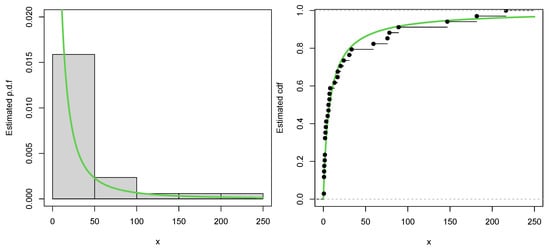
Figure 9.
Estimated p.d.f (left) and CDF (right) of the GAEPPR model corresponding to runoff data.

Figure 10.
KMS plots of the GAEPPR model for (a) the strength glass fiber data (left) (b) the runoff data (right).
7. Conclusions
In this article, we proposed the GAEP-G family of distributions, which is a new family of continuous distributions. In this regard, a four-parameter special model, GAEPPRD, was thoroughly studied. A few properties of GAEPPRD were derived analytically. A new performance method was checked by MCSS. To demonstrate the capability of the GAEPPRD, we considered two lifetime datasets and matched the DMs and GFMs with other distributions. By considering certain AMs, the GAEPPRD was ’outclass’. We hope that the new contribution will be helpful and will draw in more extensive applications in the field of distribution theory.
Author Contributions
Conceptualization, S.H., M.U.H. and R.A.; Data curation, M.S.R. and M.U.H.; Formal analysis, S.H. and M.S.R.; Investigation, S.H., M.S.R. and R.A.; Methodology, M.U.H. and R.A.; Software, M.S.R. and M.U.H.; Supervision, R.A.; Validation, M.U.H.; Visualization, S.H.; Writing—original draft, S.H. and M.S.R.; Writing—review & editing, M.U.H. and R.A. All authors have read and agreed to the published version of the manuscript.
Funding
This research received no external funding.
Institutional Review Board Statement
Not applicable.
Informed Consent Statement
Not applicable.
Data Availability Statement
The data are fully available in the article and the mentioned references.
Acknowledgments
The authors are thankful to the reviewers for their valuable corrections/suggestions, which improved the article.
Conflicts of Interest
The authors declare no conflict of interst.
References
- Rayleigh, J. On the resultant of a large number of vibrations of the same pitch and of arbitrary phase. Philos. Mag. 1980, 10, 73–78. [Google Scholar] [CrossRef] [Green Version]
- Eugene, N.; Lee, C.; Famoye, F. Beta-normal distribution and its applications. Commun. Stat. Methods 2002, 31, 497–512. [Google Scholar] [CrossRef]
- Bourguignon, M.; Silva, R.B.; Cordeiro, G.M. The Weibull-G family of probability distributions. J. Data Sci. 2014, 12, 53–68. [Google Scholar] [CrossRef]
- Cordeiro, G.M.; de Castro, M. A new family of generalized distributions. J. Stat. Comput. Simul. 2011, 81, 883–898. [Google Scholar] [CrossRef]
- Alexander, C.; Cordeiro, G.M.; Ortega, E.M.M.; Sarabia, J.M. Generalized beta-generated distributions. Comput. Stat. Data Anal. 2012, 56, 1880–1897. [Google Scholar] [CrossRef]
- Gupta, R.C.; Gupta, P.I.; Gupta, R.D. Modeling failure time data by Lehmann alternatives. Commun. Stat. Theory Methods 1998, 27, 887–904. [Google Scholar] [CrossRef]
- Torabi, H.; Montazari, N.H. The gamma-uniform distribution and its application. Kybernetika 2012, 48, 16–30. [Google Scholar]
- Marshall, A.W.; Olkin, I. A new method for adding a parameter to a family of distributions with application to the exponential and Weibull families. Biometrika 1997, 84, 641–652. [Google Scholar] [CrossRef]
- Haq, M.A.; Handique, L.; Chakraborty, S. The odd moment exponential family of distributions: Its properties and applications. Int. J. Appl. Math. Stat. 2018, 57, 47–62. [Google Scholar]
- Cordeiro, G.M.; Ortega, E.M.M.; Popović, B.V.; Pescim, R.R. The Lomax generator of distributions: Properties, minification process and regression model. Appl. Math. Comput. 2014, 247, 465–486. [Google Scholar] [CrossRef]
- Tahir, M.H.; Cordeiro, G.M. Compounding of distributions: A survey and new generalized classes. J. Stat. Distrib. Appl. 2016, 3, 13. [Google Scholar] [CrossRef] [Green Version]
- Alzaatreh, A.; Lee, C.; Famoye, F. A new method for generating families of continuous distributions. Metron 2013, 71, 63–79. [Google Scholar] [CrossRef] [Green Version]
- Mahdavi, A.; Kundu, D. A new method for generating distributions with an application to exponential distribution. Commun. Stat.-Theory Methods 2017, 46, 6543–6557. [Google Scholar] [CrossRef]
- Hussein, M.; Elsayed, H.; Cordeiro, G.M. A New Family of Continuous Distributions: Properties and Estimation. Symmetry 2022, 14, 267. [Google Scholar] [CrossRef]
- Moors, J.J.A. A quantile alternative for kurtosis. Statistician 1998, 37, 25–32. [Google Scholar] [CrossRef] [Green Version]
- Kenney, J.; Keeping, E. Mathematices of Statistics, 3rd ed.; Von Nostrand: Princeton, NJ, USA, 1962; Volume 1. [Google Scholar]
- Rényi, A. On measures of entropy and information. Hung. Acad. Sci. 1961, 4, 547–561. [Google Scholar]
- Malik, A.S.; Ahmad, S.P. Alpha Power Rayleigh Distribution and Its Application to Life Time Data. Int. Conf. Recent Innov. Sci. Agric. Eng. Manag. 2017, 6, 212–219. [Google Scholar]
- Kang, M.S.; Goo, J.H.; Song, I.; Chun, J.A.; Her, Y.G.; Hwang, S.W.; Park, S.W. Estimating design floods based on the critical storm duration for small watersheeds. J. Hydro-Environ. Res. 2013, 7, 209–218. [Google Scholar] [CrossRef]
- Ali, M.; Khalil, A.; Ijaz, M.; Saeed, N. Alpha-Power Exponentiated Inverse Rayleigh distribution and its applications to real and simulated data. PLoS ONE 2021, 16, e0245253. [Google Scholar] [CrossRef] [PubMed]
Publisher’s Note: MDPI stays neutral with regard to jurisdictional claims in published maps and institutional affiliations. |
© 2022 by the authors. Licensee MDPI, Basel, Switzerland. This article is an open access article distributed under the terms and conditions of the Creative Commons Attribution (CC BY) license (https://creativecommons.org/licenses/by/4.0/).